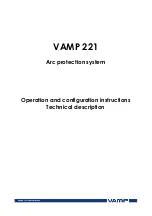
Mounting and Commissioning
3.3 Commissioning
SIPROTEC, 7SD5, Manual
C53000-G1176-C169-5, Release date 02.2011
561
A short-circuit is simulated outside Z1, with
POTT
or
UNBLOCKING
inside Z1B, with
Dir.Comp.Pickup
some-
where in forward direction. This may be done with secondary injection test equipment. As the device at the op-
posite line end does not pick up, the echo function comes into effect there, and consequently a trip command
is issued at the line end being tested.
If no trip command appears, the signal transmission path must be checked again, especially also the assign-
ment of the echo signals to the transmit outputs.
In case of a phase-segregated transmission the above-mentioned checks are carried out for each phase. The
correct phase allocation is also to be checked.
This test must be performed at both line ends, in the case of three terminal lines at each end for each signal
transmission path.
The functioning of the echo delay time and the derivation of the circuit breaker switching status should also be
tested at this time (the functioning of the protection at the opposite line end is tested):
The circuit breaker of the protected feeder must be opened. The circuit breaker at the opposite line end also
must be opened. As described above, a fault is again simulated. A receive signal impulse delayed by somewhat
more than twice the signal transmission time appears via the echo function at the opposite line end, and the
device generates a trip command.
The circuit breaker at the opposite line end is now closed (while the isolators remain open). After simulation of
the same fault, the receive and trip command appear again. In this case however, they are additionally delayed
by the echo delay time of the device at the opposite line end (0.04 s presetting, address
2502
Trip/Echo
DELAY
).
If the response of the echo delay is opposite to the sequence described here, the operating mode of the corre-
sponding binary input (H-active/L-active) at the opposite line end must be rectified.
The circuit breaker must be opened again.
These tests must be performed at both line ends, on a three terminal line at each line end for each transmission
path. However, please finally observe the last margin heading„ Important for all procedures“!
Checking in Blocking Scheme
Requirements:
Teleprot. Dist.
is configured in address
121
to the comparison schemes using blocking
signal, i.e
BLOCKING
; in addition, at address
2101
FCT Telep. Dis.
ON
is switched. Naturally the corre-
sponding send and receive signals must also be assigned to the corresponding binary output and input.
For more details about the function of the blocking scheme refer to Subsection 2.7. In the case of the blocking
scheme, communication between the line ends is necessary.
On the transmitting end, a fault in the reverse direction is simulated, while at the receiving end a fault in Z1B
but beyond Z1 is simulated. This can be achieved with a set of secondary injection test equipment at each end
of the line. As long as the transmitting end is transmitting, the receiving end may not generate a trip signal,
unless this results from a higher distance stage. After the simulated fault at the transmitting line end has been
cleared, the receiving line end remains blocked for the duration of the transmit prolongation time of the trans-
mitting line end (
Send Prolong.
, address
2103
). If applicable, the transient blocking time of the receiving
line end (
TrBlk BlockTime
, address
2110
) appears additionally if a finite delay time
TrBlk Wait Time
(address
2109
) has been set and exceeded.
In case of a phase-segregated transmission the above-mentioned checks are carried out for each phase. The
correct phase allocation is also to be checked.
This test must be performed at both line ends, on a three terminal line at each line end for each transmission
path. However, please finally observe the last margin heading „Important for all schemes“!
















































